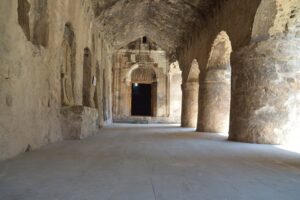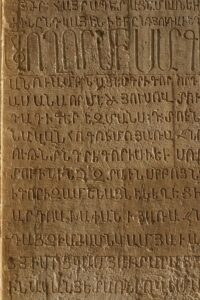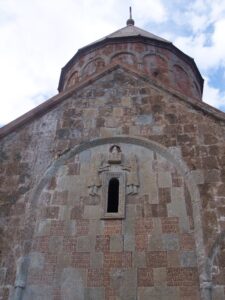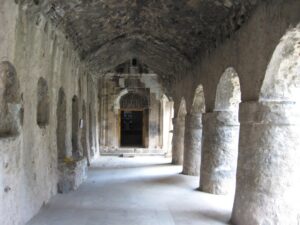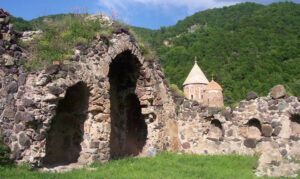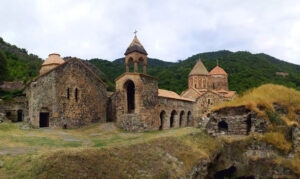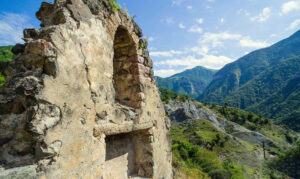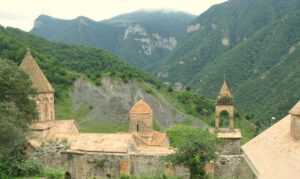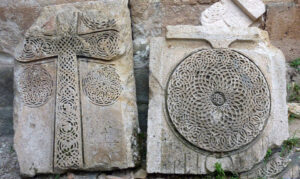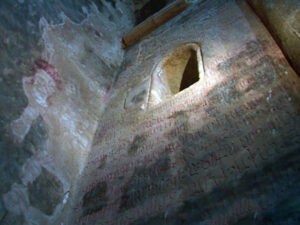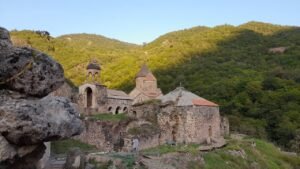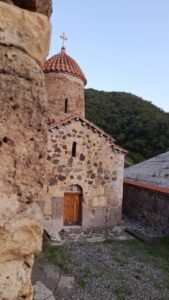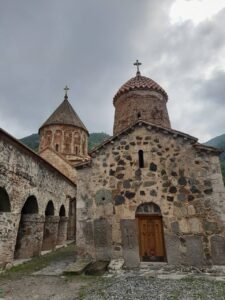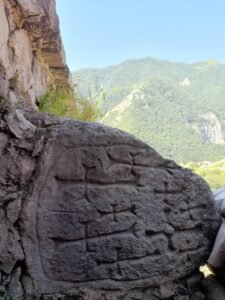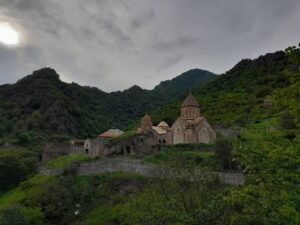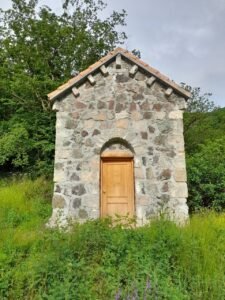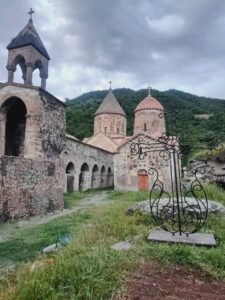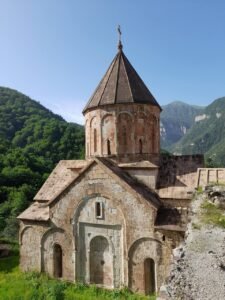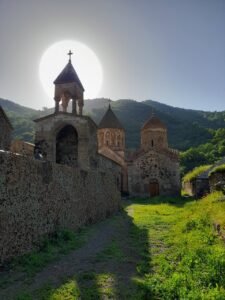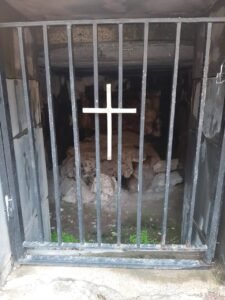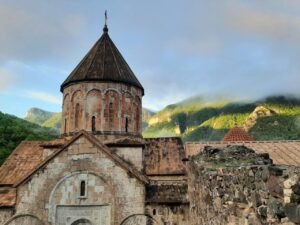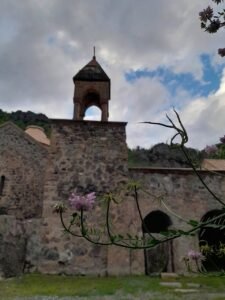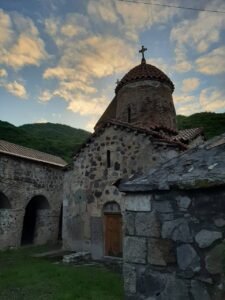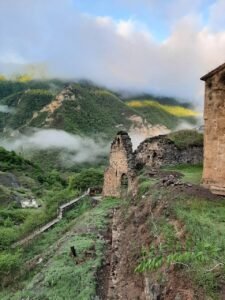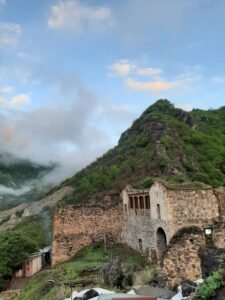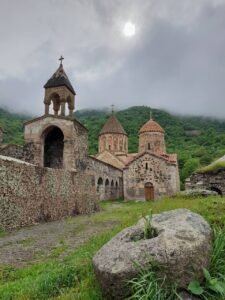Dadivank
Shahumyan Province, c. Dadivan
Դադիվանքը գտնվում է Արցախի Վերին Խաչեն կամ Ծար գավառի (այժմ՝ Քարվաճառի շրջան) արևելյան մասում, Տրտու (Թարթառ) գետի ձախ ափից 0,5 կմ հյուսիս: Վանքը գտնվում է ԼՂՀ Մարտակերտի շրջանի սահմանին խիստ մոտ՝ հազիվ 200 մ հեռավորության վրա, անտառածածկ լեռան հարավահայաց փեշին։
Դադիվանքի հիմնական հուշարձանախմբից զատ, ոչ շատ հեռու՝ շրջակա բլուրների վրա գոյություն ունեն նաև 5 մատուռներ։
Մատենագրական աղբյուրները վկայում են, որ Դադիվանքը հիմնադրվել է դեռևս առաջին դարում՝ քրիստոնեական քարոզչություն ծավալելու համար նահատակված Դադիի գերեզմանի տեղում։
Ներկա վանքի տեղում նահատակ քարոզչի գերեզմանի վրա արդեն 1-ին դարում կառուցվել է մի մատուռ (ըստ երևույթի՝ փայտաշեն), որի տեղում քրիստոնեության ընդունումից հետո՝ հավանաբար հենց 4-րդ դարում, կառուցվել է վանքի առաջին ու հնագույն եկեղեցին։
Մատենագրական աղբյուրներում Դադիվանք անվան առաջին անգամ հիշատակությանը հանդիպում ենք 9-րդ դարի սկզբին՝ Ներսես Փիլիպյանի կողմից՝ «…ի Խորաձորն, որ կոչի Դադոյի վանք»։
1145-46 թթ. պարսից Չոլի զորապետը ավերեց վանքը, սակայն նույն դարի 70-ական թվականներից սկսվում են նորոգման և նոր շինարարական աշխատանքները: Դադիվանքը շարունակում է հանդես գալ որպես առաջնորդանիստ (եպիսկոպոսանիստ) կենտրոն: 1214 թ. Վերին Խաչենի Արզու Խաթուն իշխանուհին կառուցել է Դադիվանքի հռչակավոր Սբ. Աստվածածին Կաթողիկե եկեղեցին: Համալիրի մեզ հասած շենքերի ճնշող մեծամասնությունը պատկանում են 12-րդ դարի 2-րդ կեսին ու 13-րդ դարին։
Գավիթ – ժամատունը, ըստ արձանագրության, կառուցվել է 1224թ:
Զանգակատունը սկզբից առանձին շինություն էր, ներսում տեղադրված են 1283 թվագրությամբ երկու հոյակերտ խաչքարեր: Բարձրությունը 14,6 մ է, որից 6 մ 2 — րդ հարկն է, ռոտոնդան` սրածայր վեղարով: Խաչքարերը պատկանում են համալիրի ամենափառավոր կոթողների թվին, ուստի պատահական չէ, որ օտարազգի այցելուները դրանք տեսնելով, ցանկություն են հայտնել տեղափոխել Եվրոպա, սակայն Արցախի հոգեւոր իշխանությունը մերժել է այդ առաջարկը:
18-րդ դարի վերջին և 19-րդ դարի սկզբին վանքը թափուր էր: 1760-ականներից Շուշիի Իբրահիմ խանի հրավերով վանքապատկան հողերի վրա բնակություն հաստատեցին քրդական ցեղեր և այրումներ (վերջիններս ծագումով նախ հունադավանություն, ապա մահմեդականություն ընդունած հայեր էին)։
1830-ականներին Ղարաբաղի մետրոպոլիտ Բաղդասար Հասան Ջալալյանը ձեռնարկեց նախկին վանքապատկան կալվածները վերադարձնելու գործը: Վերջում մետրոպոլիտի առաջարկությամբ և Ամենայն Հայոց Կաթողիկոս Ներսես Ե-ի միջնորդությամբ՝ Կովկասի փոխարքա Վորոնցովի կարգադրությամբ Դադիվանքին է հանձնվում 196,438 դեսիատին մակերեսով ընդարձակ կալվածք:
1910-ական թվականներին Լևոն Տեր-Ավետիքյանը նշանակվեց վանքապատկան կալվածների կառավարիչ: Մինչև 1917 թ. նրան հաջողվում է թուրքերից ու քրդերից ազատագրել բազմաթիվ ամառանոցներ և Դադիվանքին ամրագրել վանքապատկան տարածքները: Սակայն խորհրդային կարգերի հաստատմամբ վանքապատկան տարածքները նորից խլվեցին:
Դադիվանքը միջնադարյան Հայաստանի վանական խոշորագույն համալիրներից մեկն է: Գրեթե 2000-ամյակ այստեղ պարբերաբար կառուցումներ կամ նորոգումներ են իրականացվել: Վերջին տարիներին հովանավորների և պետության միջոցներով իրականացվել էին լայնածավալ շինարարական աշխատանքներ:
Մինչև 2023թ. վանական համալիրում պահպանված էր շուրջ 30 կառույց:
Դադիվանքը ճարտարապետական մի ինքնատիպ դպրոց է, որտեղ ընդհանրացված են հայ բազմադարյան ճարտարապետության լավագույն ավանդույթները։
Ներկայիս վիճակն անհայտ է:
Աղբյուրներ
- Սամվել Կարապետյան «Հայ մշակույթի հուշարձանները խորհրդային Ադրբեջանին բռնակցված շրջաններում»
- Մուրադ Հասրաթյան «Հայկական ճարտարապետության Արցախի դպրոցը»


